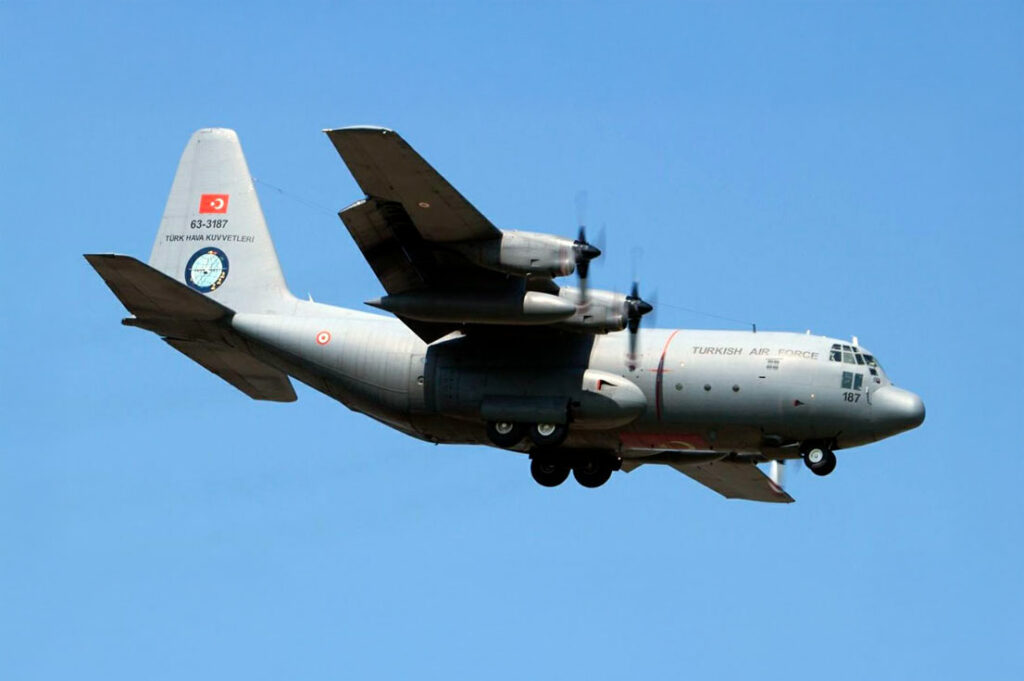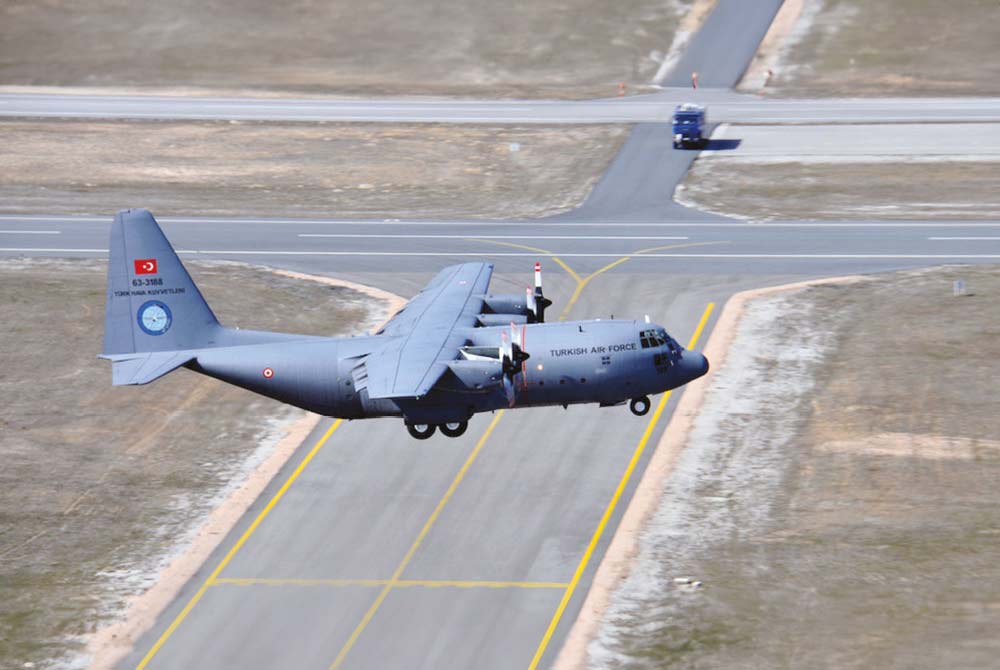The TAI Erciyes (C-130B/E) is a modernized tactical transport aircraft featuring advanced avionics, enhanced navigation systems, and improved mission capabilities.
The TAI Erciyes (C-130B/E) is an upgraded version of the legacy C-130B and C-130E Hercules transport aircraft, modernized by Turkish Aerospace Industries (TAI). The modernization program focuses on comprehensive avionics enhancements, including the integration of a digital cockpit with four-color multifunctional displays, advanced flight management systems, and compatibility with night vision goggles. The aircraft is equipped with a multifunction mission computer, Link-16 tactical data link system, and updated communication and navigation systems. These upgrades aim to improve operational effectiveness, situational awareness, and compliance with international navigation requirements, extending the service life of the fleet into the 2040s.
History of the Development of the TAI Erciyes (C-130B/E)
In the early 1950s, the U.S. Air Force identified the need for a versatile tactical transport aircraft capable of performing a wide range of missions, including troop transport, cargo airlift, and medical evacuation. This requirement led to the development of the Lockheed C-130 Hercules, which first flew on August 23, 1954. The aircraft’s robust design and exceptional performance made it a workhorse for air forces worldwide.
Turkey acquired C-130B and C-130E models to enhance its tactical airlift capabilities. Over time, advancements in avionics and the evolving nature of military operations necessitated an upgrade to these aging aircraft. In response, the Turkish Undersecretariat for Defense Industries (SSM), now known as the Presidency of Defense Industries (SSB), initiated the Erciyes Avionics Modernization Program in 2006, awarding the contract to Turkish Aerospace Industries (TAI).
The primary objective of the Erciyes program was to extend the operational life of the Turkish Air Force’s C-130 fleet by modernizing their avionics systems, ensuring compliance with international navigation standards, and enhancing mission effectiveness. The program encompassed the upgrade of 13 C-130E and 6 C-130B aircraft, totaling 19 platforms.
The first prototype, a C-130E model, was delivered to the Turkish Air Force in 2014, marking a significant milestone in the program. Subsequent deliveries continued, with the modernization process involving the integration of 23 systems and 117 components, including a newly developed central control computer designed by TAI engineers.
The Erciyes modernization aimed to reduce pilot workload, enhance situational awareness, and ensure safe flight operations through automated route tracking from takeoff to landing. By equipping the aircraft with advanced systems such as the Flight Management System (FMS), Link-16 Tactical Data Link, and night vision-compatible displays, the program ensured that the C-130B/E fleet remained a vital asset for the Turkish Air Force well into the 2040s.

Design of the TAI Erciyes (C-130B/E)
The Erciyes modernization program introduced significant design enhancements to the legacy C-130B/E aircraft, focusing primarily on avionics and mission systems. A key upgrade is the installation of a digital cockpit featuring four-color multifunctional displays (MFDs) with moving map capabilities. These MFDs provide pilots with real-time flight data, improving situational awareness and decision-making.
The integration of two Central Display Units (CDUs) and two multifunction Central Control Computers ensures compatibility with international navigation requirements. The Flight Management System (FMS) developed by TAI replaces the traditional navigator role, reducing the crew complement from five to four and streamlining flight operations.
Communication and navigation systems have been overhauled to include advanced military and civilian capabilities. Upgrades encompass GPS, indicators, anti-collision systems, weather radar, and night-time invisible lighting suitable for military missions. The aircraft is also equipped with a black box voice recorder and advanced automated flight systems, enhancing both safety and operational efficiency.
A significant addition is the Link-16 Tactical Data Link System, which enables real-time data exchange with other platforms, including modernized F-16s and E-7T Airborne Early Warning and Control Aircraft. This interoperability enhances coordinated operations and situational awareness across the fleet.
The modernization also includes the development of a Ground Mission Planning Unit compatible with the Air Force Information System, allowing for efficient pre-mission planning and post-mission analysis. Display and lighting systems have been upgraded to be compatible with Night Vision Goggles (NVG), facilitating safe operations under low-light conditions.
These design enhancements collectively improve the aircraft’s operational capabilities, ensuring compliance with contemporary aviation standards and extending the service life of the fleet.
Performance of the TAI Erciyes (C-130B/E)
The TAI Erciyes (C-130B/E) retains the four Allison T56-A-7 turboprop engines, each producing 4,200 shaft horsepower (3,132 kW). These engines provide the aircraft with a cruise speed of 540 km/h (336 mph, 291 knots) and a maximum speed of 602 km/h (374 mph, 325 knots) at an altitude of 6,100 m (20,000 ft).
The operational ceiling is 10,060 m (33,000 ft), while its rate of climb reaches 580 m/min (1,900 ft/min). The aircraft has a takeoff distance of approximately 1,200 m (3,940 ft) when fully loaded and a landing distance of 1,005 m (3,300 ft) under optimal conditions. The range varies based on the payload, reaching 3,800 km (2,361 mi, 2,052 nmi) with a standard cargo load and extending up to 7,300 km (4,536 mi, 3,943 nmi) with additional fuel tanks.
A crucial aspect of the Erciyes modernization program is the improvement in fuel efficiency and operational range through flight management system (FMS) upgrades. These allow for optimized routing, reducing fuel consumption and enhancing mission endurance. The incorporation of digital engine control systems also contributes to maintaining engine performance and reducing wear over extended operational periods.
Compared to similar medium-lift transport aircraft, the Erciyes (C-130B/E) remains versatile in its role but faces competition from newer models. For example, the Lockheed C-130J Super Hercules features Rolls-Royce AE 2100D3 turboprop engines, producing 4,637 shaft horsepower (3,459 kW) each, allowing a higher cruise speed of 643 km/h (400 mph, 345 knots) and extended range capabilities. However, the TAI Erciyes modernization provides a cost-effective alternative, leveraging existing airframes while integrating advanced avionics and mission systems.
In terms of payload capacity, the C-130B/E variant can carry up to 20,400 kg (45,000 lb), accommodating 92 troops, 64 paratroopers, or 74 stretchered casualties with attendants. It also supports various cargo configurations, including palletized loads, oversized equipment, and airdrop missions.
The aircraft’s short takeoff and landing (STOL) capabilities enable operations from unprepared runways, making it well-suited for military logistics, humanitarian missions, and rapid troop deployment. The improved navigation and situational awareness systems under the Erciyes program further enhance its adaptability for complex operations, including low-level flight and tactical ingress/egress maneuvers.
While the C-130J and Airbus A400M Atlas offer superior performance in range and fuel efficiency, the TAI Erciyes (C-130B/E) modernization remains a viable solution for nations seeking cost-effective fleet upgrades without investing in entirely new platforms. The Erciyes retains the rugged reliability of the original Hercules design while integrating modern capabilities essential for 21st-century air operations.

Variants of the TAI Erciyes (C-130B/E)
The TAI Erciyes (C-130B/E) modernization program applies to two specific legacy variants:
- C-130B Erciyes: The older model, originally introduced in the 1960s, featuring structural enhancements and full avionics modernization under the TAI upgrade. This version retains its original T56-A-7 engines but benefits from digital flight systems, Link-16 tactical data integration, and enhanced navigation.
- C-130E Erciyes: A later model with increased fuel capacity and higher payload capabilities compared to the C-130B. This variant benefits from similar avionics upgrades but retains its extended range and endurance, making it more suitable for long-haul military transport missions.
Both variants now feature a digital cockpit with multifunctional displays, automated mission planning systems, and enhanced situational awareness tools, significantly improving flight safety and operational efficiency.
Military Use and Combat of the TAI Erciyes (C-130B/E)
The TAI Erciyes (C-130B/E) serves as a tactical airlift and logistics aircraft for the Turkish Air Force, primarily used for troop transport, cargo delivery, medical evacuation, and airdrop operations. It plays a crucial role in strategic air mobility, ensuring rapid deployment of personnel and equipment to conflict zones and disaster-stricken areas.
Combat and Operational Deployments
While the C-130 platform has been used in multiple military engagements worldwide, the Erciyes (C-130B/E) variant has been deployed primarily in Turkish military operations.
One of its significant roles has been in counter-insurgency and special operations support. The aircraft has been used in cross-border operations in Syria and Iraq, providing logistical support for Turkish military forces. In Operation Euphrates Shield (2016-2017), Turkish forces relied on C-130 aircraft for rapid resupply missions to forward operating bases.
In addition to military operations, the Erciyes (C-130B/E) is frequently used in NATO missions and joint exercises. Turkey, as a member of NATO, contributes its modernized Hercules fleet to alliance-wide operations, including strategic airlift support for NATO Response Force (NRF) deployments.
Humanitarian and Peacekeeping Missions
Beyond combat roles, the TAI Erciyes (C-130B/E) has been instrumental in humanitarian assistance and disaster relief missions. In response to the 2023 Kahramanmaraş earthquakes, Turkish Air Force C-130s delivered emergency supplies and medical aid to affected regions. The aircraft’s ability to land on short and unprepared airstrips was critical in ensuring aid reached remote locations.
Additionally, Turkey has deployed Erciyes C-130s for United Nations peacekeeping missions, supporting troop rotations and logistical resupply for Turkish contingents in conflict zones.
Competing Aircraft and Global Sales
The Erciyes modernization program has not resulted in direct foreign sales; however, the C-130 Hercules platform remains widely used by air forces globally. Countries looking for affordable modernization solutions have shown interest in similar upgrade packages. While the Lockheed C-130J Super Hercules is the preferred choice for nations seeking new aircraft, the Erciyes modernization provides an alternative for extending the life of existing fleets.
As of 2024, the Turkish Air Force continues to operate its Erciyes C-130B/E fleet, with an expected service life extending into the 2040s. There are no immediate plans for a full replacement, but Turkey is evaluating future airlift solutions, including the Airbus A400M Atlas, already in limited service with the Turkish Air Force.
Back to Transport planes.